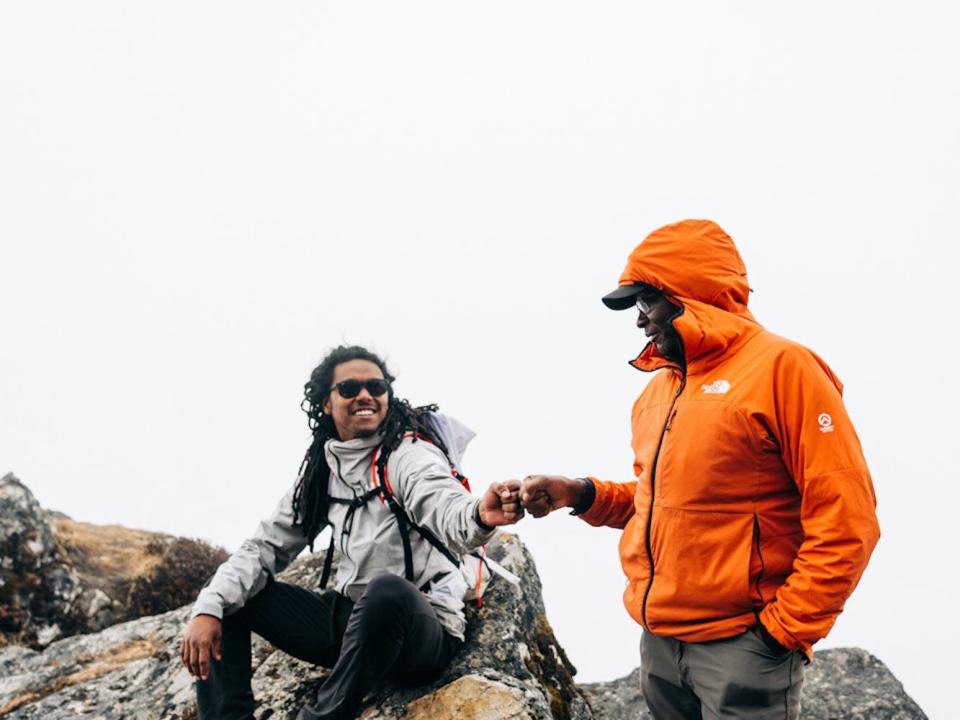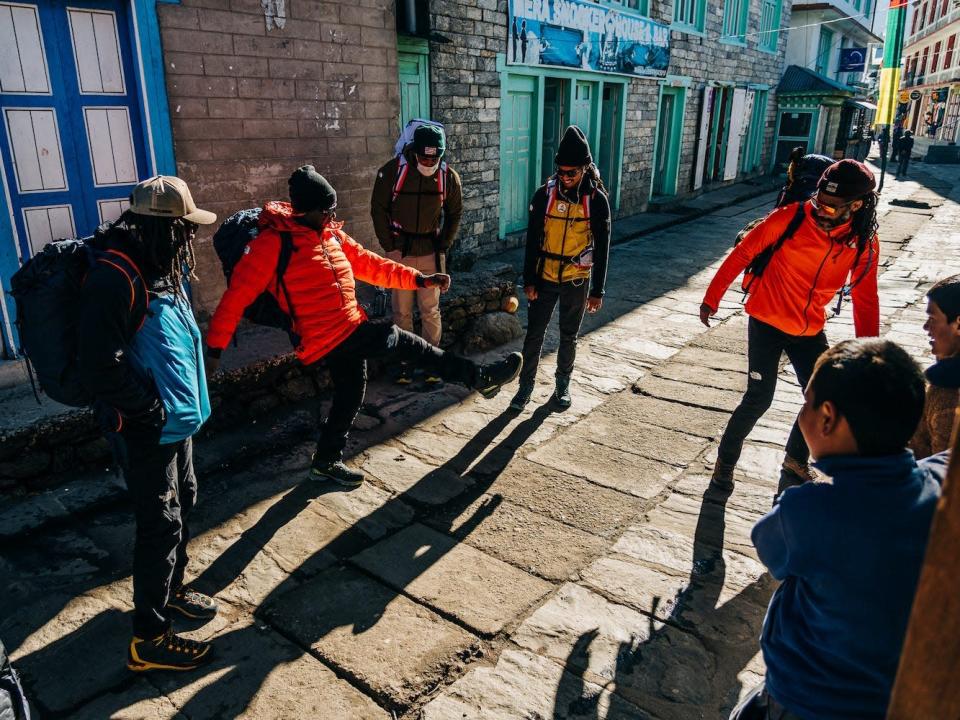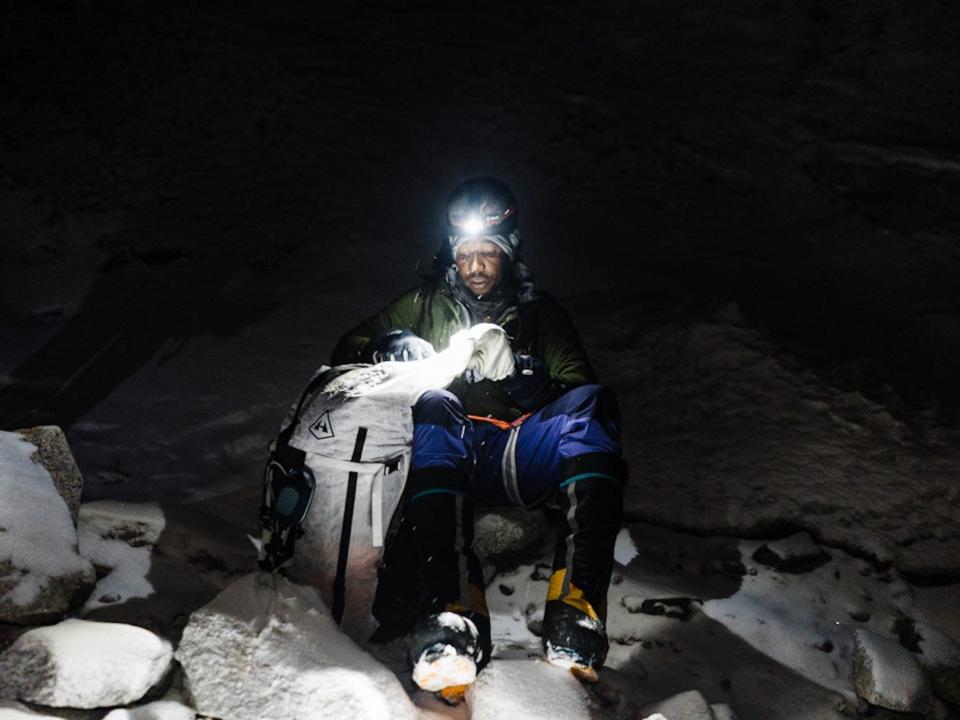The first all-Black team to summit Mount Everest shares the best and worst moments of the 50-day journey
[ad_1]

-
The first, all-Black team, dubbed Full Circle Everest, successfully summited Mount Everest in mid-May.
-
Insider spoke to four members of the team about the journey’s best and worst moments.
-
The group formed a family bond, but varying temperatures and sleep deprivation added challenges.
On May 12, the Full Circle Everest team made history as the first all-Black climbing group to summit Mount Everest, the world’s highest peak. The achievement nearly doubled the total number of Black climbers who have summited the 29,032-foot mountain.

The 11-person Full Circle Everest team led by Philip Henderson included Fred Campbell, Adina Scott, Evan Green, Manoah Ainuu, James “KG” Kagambi, Rosemary Saal, Desmond “Dom” Mullins, Abby Dione, Eddie Taylor, and Thomas Moore. A group of 12 Sherpa guides, who are indigenous to the Himalayan region, also joined the team.
Seven members, Ainuu, Taylor, Saal, Mullins, Moore, Kagami, and Green, successfully summited the highest mountain on earth.
According to Outside, before their expedition, there were approximately 6,000 successful summits of Everest. Of those 6,000 climbers, only 10 identified as Black.
On May 12, the Full Circle Everest group nearly doubled that representation, creating a grand total of 17 Black climbers to reach the top of the mountain.
Insider spoke to four members of the team, who shared intimate details about the journey. The trek encompassed two years of planning and 50 days to complete.

After their climb, Insider spoke to Moore, Scott, Campbell, and Green about the highs and lows of the expedition.
Summiting Mount Everest started as just an idea by Henderson in 2020, Campbell said. Henderson had successfully summited before, and after a conversation with other Black mountaineers, Henderson decided to form the first team of all-Black climbers.
Henderson put out the word through the mountaineering community and assembled a group. After months of training and COVID-19-related delays, they successfully made history in May 2022.
The group quickly became a family, the four members said in agreement.

In January, the team traveled to Nepal for a training hike, which helped familiarize them with the region before starting the summit of Everest in April.
The trip was the first time they were all together since the climbers reside in different parts of the world. Scott is from the Pacific Northwest; Green lives in Alburquerque, New Mexico; Moore is based in Denver, Colorado, and Campbell resides in Seattle, Washington. Other members of the Full Circle Everest team live in Florida, Montana, New York, and Kenya.
This trip began their bonding as a team, Green said. That included their various roles. Green, for instance, served as a photographer for the trip, and Scott helped the team with technology.
The unit only strengthened from there, Scott said.
Fast forward to April when they started the official expedition, and “it felt like we were coming home in a way,” Green said.
“The best part was just the amount of love, teamwork, and family building — all the little inside jokes that we have now with each other and with our Sherpa team,” Scott said.
Those highlights ranged from dance parties in camp kitchens to “poking fun” at each other, she said. Together, the four agreed the bond they formed was one of the most incredible parts of the entire expedition.
Campbell added that “the hours we wasted” were some of his favorite memories from the trip.

In order to summit Everest, climbers stop at camps along the route up the mountain to acclimate their bodies to the high altitudes.
That meant a lot of hanging out, Campbell said.
The group played everything from the guessing game Heads Up to chess on a miniature chessboard. They watched movies and blasted songs by J Cole and Kendrick Lamar.
“Just getting to hang out with people you enjoy being around was fun,” he said.
Team dinners at traditional Tibetan teahouses were Moore’s favorite part.

The initial ascent to the Mount Everest basecamp is drastically different from the ascent once climbers reach higher altitudes, one Full Circle Everest climber told NPR. Climbers hike a scenic route, with comforts like motels for overnight stays and traditional Nepali teahouses for meals.
Moore described a teahouse as a big, open room filled with other trekkers and climbers.
Together, the groups would drink tea, eat typical Nepali fare like Dal Bhat, a lentil, stew, and rice dish, and hang out in a way that reminded Moore of “a bar feeling,” he said. He added that laughter, jokes, and good music accompanied their meals.
Not only were the dinners an opportunity to experience Nepali culture, but they were another chance to bond, Moore said.
Learning about Nepali culture from locals and their Sherpa guides was a highlight of their journey.

The team developed relationships with each other but also with the Sherpa guides who helped them summit.
“They were a huge part of the team,” Campbell said. “It was nice for us to be able to start our own relationships with people in the area.”
The team of Sherpas included Pasang Nima Sherpa, Lhakpa Sonam Sherpa, Phurtemba Sherpa, Dawa Chhiri Sherpa, Sonam Gaylje Sherpa, Nima Nuru Sherpa, Chopal Sherpa, chawang Lhendup Sherpa, Tasha Gyalje Sherpa, Amrit Ale, Pemba Sherpa, and Nawang Tenji Sherpa.
Sherpas are widely known for their mountaineering skills. During an Everest expedition, Sherpas help climbers carry their loads, set up camps, secure climbing routes, and guide climbers to the peak, according to NPR.
“Experiencing the culture in Nepal and experiencing, firsthand, what the local communities, particularly the Sherpa community, does for mountaineering was huge,” Scott said. “Then, being able to bring that knowledge home.”
Expanding representation in the climbing community was another impactful part of the trip, according to the four team members.

Beyond making history, the team shared that a part of their mission was to increase representation in the climbing community.
“There is a lack of representation of Black people in mountaineering and in high-altitude mountaineering,” Henderson told NPR. “There’s so few of us at this level that it’s our duty, in a sense, to bring this to our communities, to our young people, and talk about the benefits of connecting with nature.”
Campbell echoed Henderson’s sentiment, adding that this expedition was “a chance to inspire other people.”
Of course, reaching the peak of Everest was an achievement for two members, Green and Moore.

Seven members of the Full Circle Everest group successfully summited Everest, including Moore and Green.
Green reached the summit around sunrise. He said there was a moment “of realizing you made it and that all that work and that progress had paid off.”
Meanwhile, Moore was the last person in the group to summit. Looking back, he said he realized he didn’t even take a photo. Instead, he reached the top, sat down, and reveled in the view of mountains spanning the horizon.
“I just wanted to take it all in,” he said.
Returning to basecamp after reaching the summit was Green’s favorite part.

Once Green reached the summit, he said he quickly realized how much work was still ahead of him.
“You look down and see Camp Two, and it was a little tiny dot,” Green said. “We had to go back. You still had a lot of work in front of you even at the summit.”
The journey to the summit took 36 days, but Green and his fellow climbers still had 14 more days before their trip would be complete. Just as the trek up was challenging, so was the descent back to basecamp, Green said.
When he finally arrived at the basecamp, he said he was welcomed with cold beer and soda.
Beyond celebratory drinks, arriving at the camp gave him time to process what he had just accomplished.
“It was amazing, to realize everything that led up to that moment,” he said.
The trip wasn’t without challenges. For Scott, the marathon-like nature of climbing Mount Everest was the toughest aspect.

The team’s entire trip spanned almost two months.
Scott said that being away from home and sleeping in tents included both good days and bad days.
“You don’t have all the people around you or the comforts around you that usually do,” she said. “Everyone is going to get on your last nerve at some point.”
Tackling tough days was harder to do on Mount Everest than back home, she said.
“They’re hard to navigate when you’re camped on the edge of a glacier and can’t just go to the corner bar and vent to your usual bartender,” she said.
While it was a challenge, Scott stressed that every part of the expedition was worth it.
Moore was surprised by the heat at the beginning of the expedition.

When people think of climbing Mount Everest, they typically picture layers of warm clothes, thick gloves, and ice picks, but freezing temperatures aren’t consistent on the entire trip.
Climbers who start in Nepal will trek through the Western Cwm, where temperatures can reach 90 degrees Farenheight, according to CNN. Since the Western Cwm is in a glacial valley, the powerful sun reflects off of ice and snow. The valley also means that temperatures can change fast, so climbers still don warm clothing.
Simply put, Moore said that the camp in Western Cwm was hot, really hot.
“It got so hot going from Camp One to Camp Two,” he said. “I was not prepared for that.”
The team expected long days and a lack of sleep, but it was still grueling.

The climbers knew what they signed up for, but experiencing the lack of sleep, long days, and physical exhaustion was still tough, they all agreed.
“It was taxing,” Green said. “Mentally [it] could be difficult, but it’s also part of the adventure.”
Facing illness, and the reality of how that affected his trip, was a mental and emotional hurdle for Campbell.

Campbell developed a respiratory infection in the middle of the summit push, and ultimately, was unable to summit Everest.
“Camp Two was when I realized that I would have to go down while everyone else continued up,” he said. “After all the preparation and years of planning, it was over.”
Knowing that he wouldn’t make it to the summit was disappointing, he said, but “it was a great feeling to celebrate vicariously.”
“You can be both disappointed and excited at the same time,” he said.
The summit is just the beginning, the team agrees.

When thinking about the history they made and their impact on the climbing industry, Scott said they hope the summit of Everest is just the start.
“I’m excited to see where it goes from here,” Scott said.
“Everyone was able to have fun on the trip and everyone was able to come home safely, so that was our biggest success,” Green said.
Read the original article on Insider
[ad_2]
Source link
